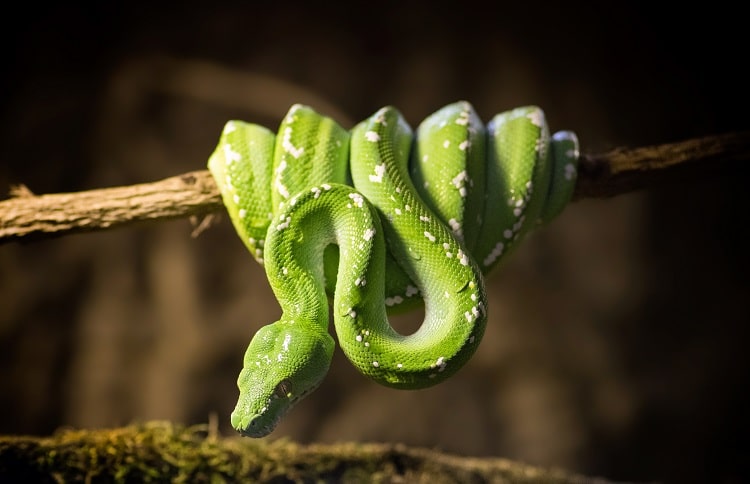
Overview: About the Green Tree Python
So named for its vibrant and bright green color, the green tree python (scientific name Morelia viridis) is a non-venomous arboreal snake which is native to the tropical rainforests of the islands in Eastern Indonesia, New Guinea, and the Cape York Peninsula of Australia.
The green tree python doesn’t take its characteristic green color until they are about 6-12 months old. The juveniles are born red, bright yellow, or red-brown.
The striking color morph is always a wonder, and the coloring itself makes the green tree python a great display snake.
This snake has a slim body, a long tail, and a strong, muscular head.
Green Tree Python as a Pet
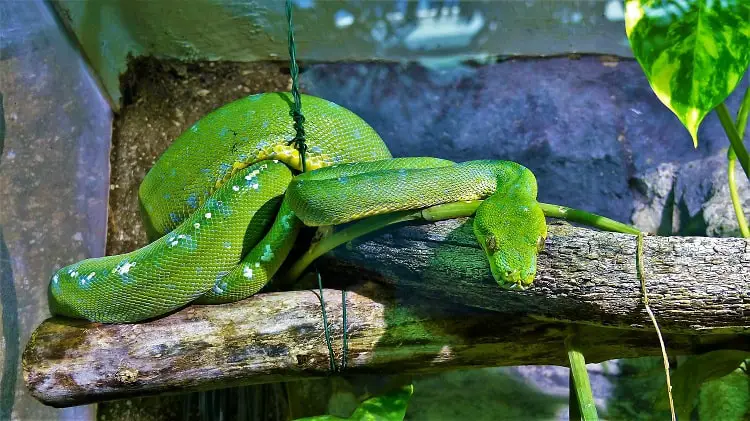
This snake species is becoming more and more popular in the reptile pet industry. Reptile enthusiasts are drawn to the snake’s stunning colors, and many say that watching the color morph of these snakes has to be one of the most fascinating things ever.
Like any other pet, your green tree python will require caring. This post will look at how to properly care for your pet snake, focusing on its housing needs, feeding, and health concerns, among other areas.
You will explore what you should expect and the dos and don’ts of caring for your green tree python.
Housing Needs
Choosing the Right Size
Contrary to common belief, the green tree python does not require a tall enclosure. Yes, in the wild, you will find these snakes typically perched on a branch. As a kept pet, it really makes no difference how high up the branch is from the ground.
In any case, the green tree python is highly nocturnal. During the day, it will stay mostly in one spot throughout the day, only moving from, say, a basking area to a place that’s cooler in order to thermoregulate.
You’ll therefore want to keep some perches and branches on the warmer side of your snake’s housing enclosure and some on the cooler side.
When shopping around or making an enclosure for the green tree python, you may want to get a cage that is in the range of 2-3 feet tall.
You don’t want to make your snake’s housing too tall. Why? The snake will instinctively climb to the highest spot and will remain perched there for a long time.
More often than not, the python will be too lazy to climb down and have a drink which can cause dehydration with all its health repercussions.
A 3’x3’x3’enclosure would be perfect for an adult green tree python. Not only is such an enclosure cost-effective, but you will also have an easier time maintaining the right temperature and humidity in the cage.
A smaller enclosure will do for a baby green tree python.
Enclosure Design
Apart from the dimensions of the enclosure, you will also want to pay attention to the style or design of the enclosure, and in particular, how it opens.
An enclosure that opens from the front will make cleaning up, feeding, and handling your green tree python easier than one that opens from the top.
Furnishings for the Cage
Provide your snake with something on which to climb. Have multiple sturdy branches or perches for your snake. You want to make sure each of these is securely fastened to the bottom of the cage.
This will avoid accidents where the branch collapses underneath your snake, or falls on top of the snake.
Apart from the perches, you can add some rocks throughout the enclosure, so your snake has various perching or resting surfaces.
If you can, then add some live plants. Not only do live plants make the enclosure look nice, but they are also a natural source of camouflage and cover for your snake.
Additionally, live plants help with raising the humidity levels in the cage.
Substrates for the Cage
A substrate is what you will use to cover the bottom of your snake’s cage. The green tree python does well in a variety of substrates, including coconut husk, paper products, and dampened mulch.
You want to stay away from substrates that are too dusty, as these may irritate your snake if it inhales them. Go for one that’s easy to clean.
You also don’t want a substrate that gets easily wet, as too much wetness can irritate your python’s scales, even causing scale rot.
Temperature and Lighting
In their natural habitat, green tree pythons will need both temperature and lighting, which are the same all year round. You can provide 12-hours of daylight and 12 hours of night each day using a UV lamp equipped with a timer.
A warm environment is a must, as the natural habitats in the tropical rainforests are warm. Keep track of the temperature in your snake’s enclosure using two thermometers placed on either side of the cage.
Give your python options by keeping one side of the cage warmer and the other cooler.
You can keep the temperature at the desired level using any one or more of several tools. This includes using a ceramic heat emitter, placing a basking light over the cage, or using a heating mat under the cage.
Whatever your choice, make sure your python cannot touch the heat source.
Humidity Levels
In the natural habitat, conditions are warm and humid. You want to keep the humidity levels in your snake’s enclosure within the 40-70% range. A higher humidity level may be necessary during the shedding period to ensure your snake is more comfortable.
Use a hygrometer to keep track of the humidity levels. You can adjust the humidity level with daily misting. Adding a larger water bowl will also help, as will adding some live plants to the cage.
You can also improve the humidity levels by covering part of the cage with a towel.
Keeping the Cage Clean
Make a point of spot cleaning every time you see your python has left some waste. It should do to keep your snake’s little home clean.
You also want to clean out the whole cage, giving it a thorough clean at least once every month. You should also replace an inch of the substrate every week.
Feeding a Green Tree Python:
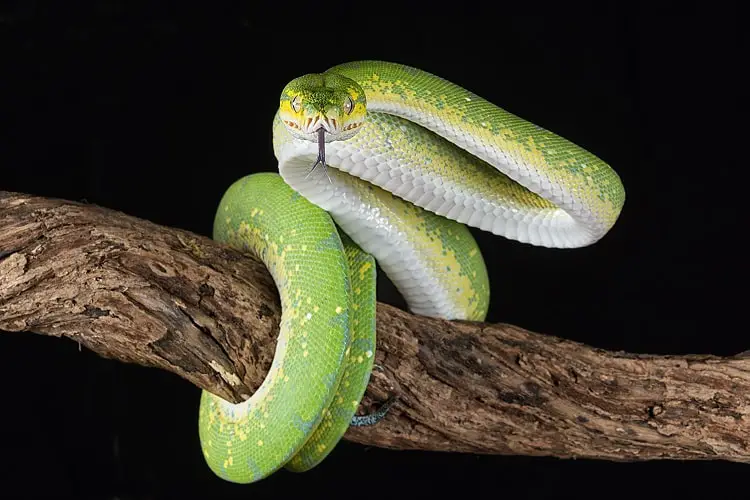
Diet and Feeding Schedule
Green tree pythons are not picky eaters. A diet comprising appropriately-sized rodents will do just fine.
For a juvenile python, you will want to feed them a small mouse after every few days, typically 5-7 days.
If yours is an older juvenile, a feed every 7-10 days will suffice. On the other hand, if you have an adult green tree python, you will want to do a meal of a medium-sized rat or a mouse every 10-14 days.
Be careful not to overfeed your green tree python. Because they are highly sedentary, you would want to keep a check on the feeding to reduce the risk of your python becoming overweight and developing health complications over the same.
Also, pay close attention to the size of the rodent you feed your python, especially for the younger snakes. If the meal is too big, your python may have some problems with regurgitating the food.
Juveniles tend to eat even through the winter, provided they are warm enough. On the other hand, adult green tree pythons tend to keep off food during the winter.
It is perfectly alright to let your python skip meals during this time, but you must ensure you keep an eye on its body weight and wait it out until your snake starts feeding again.
Also, avoid handling your python in the hours leading up to feeding time. Avoid handling it for at least a day after your snake has had its meal.
Handling your snake before mealtime will make it associate handling time with feeding.
Handling after meals can be uncomfortable for your snake, causing irritation, which may lead to it regurgitating its meal.
Water for Your Green Tree Python
A green tree python will more than often drink droplets of water from the side of the enclosure.
Stimulate the rain showers, these snakes are used to in their natural habitat using a misting system or spray bottle.
Gently spray all around the enclosure every day, and you will be encouraging your python to be more active, as it will no doubt seek moisture.
You want to ensure that the enclosure can completely dry between spraying to avoid creating that moist and warm environment which is perfect for bacteria to thrive.
Apart from letting your snake drink the droplets off of the cage’s wall, also ensure you keep some fresh, clean water in a bowl.
Your python is more likely to drink from the bowl if it is elevated, so you will want to keep the bowl high up near a perch.
Behavior, Temperament, and Proper Handling
Green tree pythons have earned the rep of being overly aggressive, but that is only true in some cases.
The wild and imported kind are often the ones to display aggressive behavior and are more likely to bite their handlers. This is expected, given the trauma inflicted during the capture of the snakes.
On the other hand, captive-bred green tree pythons can be quite even-tempered. Captive-bred juveniles can be especially nervous and shy around humans, but these are also easy to tame.
The secret lies in proper handling. Every single time you pick your green tree python, ensure you do it slowly and calmly.
You will also want to pick up your snake when it is on a perch, which makes it easy to come at it from below. Approaching your snake from above feels more threatening.
As you pick up your python, support its lower coils, all the while allowing it to move as it so wishes. Allow the snake to crawl from its resting perch and offer your arms as a perch.
Allow it to move around freely, exploring your arms and shoulders, as it so wishes.
All through, you want to always handle your snake with both hands. This way, your snake will feel more supported. Proper and gentle handling around once a week will help your snake to trust you.
Do it well, and most green tree pythons can put up with handling for short amounts of time.
Safety
Because it is non-venomous, the green tree python is not considered a dangerous snake. You really have nothing to worry about once your snake is well-tamed. You should be gentle when handling your green tree python.
This is not something that can be overstated. Do it right, and you shouldn’t have to worry about your snake biting you.
Again, even if the bite is not venomous, it can cause an infection, so you will want to see a doctor if you get bit.
As with other reptiles, the snake may carry the Salmonella bacteria. Consult with a reptile veterinarian to ascertain whether your snake has the bacteria.
You can easily avoid getting infected by the bacteria by ensuring you wash your hands thoroughly after handling your snake.
Lifespan and Health Concerns
Obtain a green tree python from a reputable seller, and you can be sure you will be getting a snake that’s well taken care of and in great health and well-being.
Once home, it is your responsibility to ensure your python stays in good health.
A proper feeding and water routing will help keep your python in good shape. You also want to maintain the right temperature and humidity balance in the cage, ensure the cage is well-sized and clean for your snake to thrive.
Have an experienced veterinarian do regular check-ups on your python. Among the most common health concerns to look out for are as follows.
- Dehydration: Common problem, but which you can avoid by ensuring the age is humid enough, and you have a water bowl in there from which your snake will drink.
- Water Blisters: On the flip side, excessive humidity may cause water blisters, so keep the humidity in check.
- Tail-Hanging: Results from inactivity and an improperly sized cage.
- Rectal Prolapse: Several factors can contribute to rectal prolapse. Ensure you get immediate medical attention for our snake.
- Ventral Dermatitis: May be because of substrate dampness and poor hygiene.
- Spinal Kinks: These permanent kinks can result from improper handling. Another theory is that spinal kinks may be because of calcium deficiency.
- Necrotic Stomatitis: This is a rot in the mouth as a result of an infection. The infection usually results from the snake hurting its mouth on rough objects or striking the glass when reaching for food.
- Respiratory Infections: These are caused by viruses and bacteria. These infections can be life-threatening and should be addressed immediately.
As highlighted, most of these health concerns can be avoided with good care and husbandry practices.
Be sure to call a veterinarian if you notice any worrying signs, including refusal to eat, wheezing sounds, mouth rot, blisters and bumps on the skin, lethargy, and more.
A specialist reptile veterinarian can accurately diagnose your snake’s condition and recommend proper treatment.
The average lifespan of a green tree python ranges between 15 to 20 years. This, of course, depends on the quality of care and health of the snake.
It is within your power to ensure your green tree python enjoys a long and healthy life.
Price/Cost
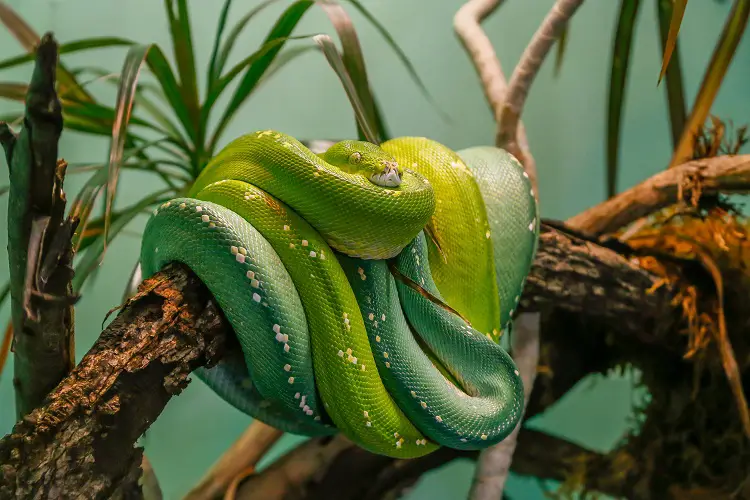
You can readily get your green tree python from different sources. The ready availability of captive-bred green tree pythons is thanks to the significant success people are having in breeding the snakes.
A private breeder, online breeder platforms, pet stores, and reptile shows are top on of that list.
Do your research and ensure you are not being part of the illegal trading of green tree pythons. Don’t let the cheaper prices offered by illegal reptile traders lure you into being a part of it.
How much will it cost you? There really is no straight answer for this, as the price depends on several factors.
The age, for starters, is quite significant. It’s expected that a full-grown adult green tree python will cost more than a hatchling or juvenile.
Price also varies by the locality of the snake. The most common type of green tree python is the Biak, from the island of Biak in Eastern Indonesia.
The price range for this variety stands at $275-$350.
Others are the Aru, Sorong, Jayapura, and Wamena, among other green tree python types.
Breeders will price the pythons according to the different localities to which the heritage of the python can be traced.
A rare type of green tree python continues to rank high among the most expensive snakes in the world.
Fact Sheet Summary and Fun Facts
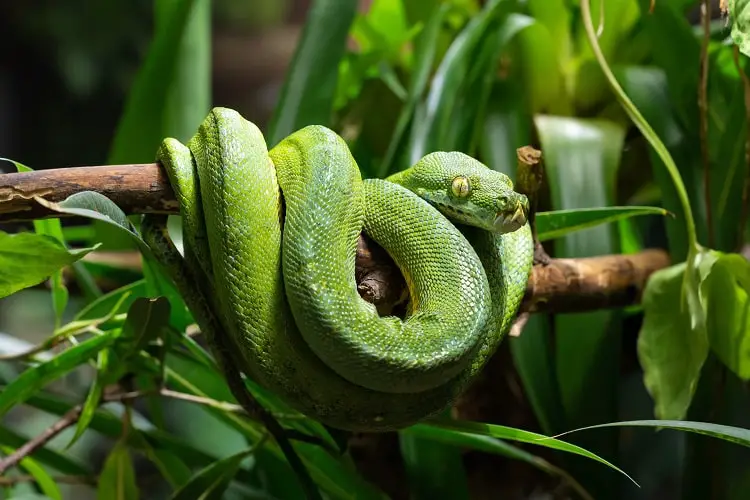
Common Name: Green Tree Python, Green Python
Scientific Name: Morelia Viridis
Family Name: Boidae
Genus Name: Morelia
Habitat: Tropical rainforest
Range: Islands of Indonesia, New Guinea, Australia
Average Length: 4-7 ft
Average Weight: 2-5 lbs.
Sexual Maturity: 3 Years
Lifespan: 15-20 Years
Diet: Small rodents (captive-bred) mammals, lizards, birds (wild)
- The hatchlings are red, blue, and yellow. They take on the green color when they mature.
- Albinism among green tree pythons is very rare. There are only a few confirmed cases.
- The spine on the green tree python is very visible.
- In the wild, the green tree python will spend most of its life in the trees, coiled around branches.
In Conclusion
It’s easy to see why this snake species is popular. Caring for a green tree python, while quite tasking, is, without doubt, rewarding.
Proper care and husbandry, as outlined, will see your snake lead a long life and keep away most health issues.

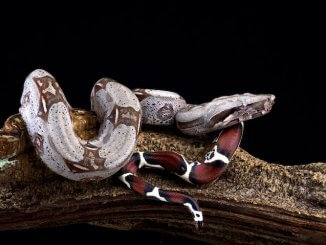
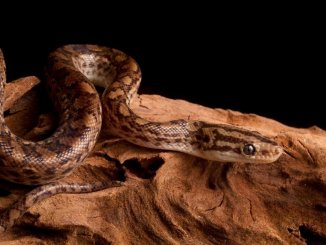
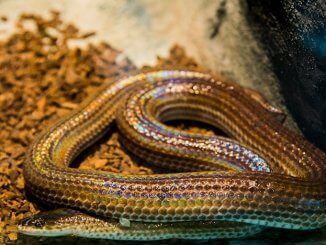

Will a 5 ft Green tree python take Large rats 170 grams in will a very Large 6ft+ take jumbo or collosal rats 250-500 grams ?
It looks like those preys would be oversized. At best, you can safely feed your GTPs some medium rats (100-130 grams).
The general rule of thumb is that you want a mice/rat which is 1.25 times the width of your snake at its widest point, so that it will create a little lump in its mid-section once ingested.